Francisella tularensis inhibits the intrinsic and extrinsic pathways to delay constitutive apoptosis and prolong human neutrophil lifespan
- PMID: 22357630
- PMCID: PMC3311780
- DOI: 10.4049/jimmunol.1102863
Francisella tularensis inhibits the intrinsic and extrinsic pathways to delay constitutive apoptosis and prolong human neutrophil lifespan
Abstract
Francisella tularensis is a facultative intracellular bacterium that infects many cell types, including neutrophils. We demonstrated previously that F. tularensis inhibits NADPH oxidase assembly and activity and then escapes the phagosome to the cytosol, but effects on other aspects of neutrophil function are unknown. Neutrophils are short-lived cells that undergo constitutive apoptosis, and phagocytosis typically accelerates this process. We now demonstrate that F. tularensis significantly inhibited neutrophil apoptosis as indicated by morphologic analysis as well as annexin V and TUNEL staining. Thus, ∼80% of infected neutrophils remained viable at 48 h compared with ∼50% of control cells, and ∼40% of neutrophils that ingested opsonized zymosan. In keeping with this finding, processing and activation of procaspases-8, -9, and -3 were markedly diminished and delayed. F. tularensis also significantly impaired apoptosis triggered by Fas crosslinking. Of note, these effects were dose dependent and could be conferred by either intracellular or extracellular live bacteria, but not by formalin-killed organisms or isolated LPS and capsule, and were not affected by disruption of wbtA2 or FTT1236/FTL0708-genes required for LPS O-antigen and capsule biosynthesis. In summary, we demonstrate that F. tularensis profoundly impairs constitutive neutrophil apoptosis via effects on the intrinsic and extrinsic pathways, and thereby define a new aspect of innate immune evasion by this organism. As defects in neutrophil turnover prevent resolution of inflammation, our findings also suggest a mechanism that may in part account for the neutrophil accumulation, granuloma formation, and severe tissue damage that characterizes lethal pneumonic tularemia.
Conflict of interest statement
Figures
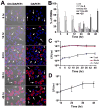

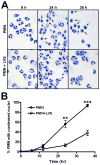

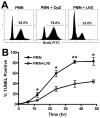
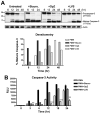


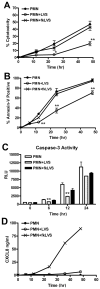


Similar articles
-
Francisella tularensis LVS evades killing by human neutrophils via inhibition of the respiratory burst and phagosome escape.J Leukoc Biol. 2006 Dec;80(6):1224-30. doi: 10.1189/jlb.0406287. Epub 2006 Aug 14. J Leukoc Biol. 2006. PMID: 16908516 Free PMC article.
-
Multifaceted effects of Francisella tularensis on human neutrophil function and lifespan.Immunol Rev. 2016 Sep;273(1):266-81. doi: 10.1111/imr.12445. Immunol Rev. 2016. PMID: 27558340 Free PMC article. Review.
-
Francisella novicida inhibits spontaneous apoptosis and extends human neutrophil lifespan.J Leukoc Biol. 2017 Sep;102(3):815-828. doi: 10.1189/jlb.4MA0117-014R. Epub 2017 May 26. J Leukoc Biol. 2017. PMID: 28550119 Free PMC article.
-
Francisella tularensis genes required for inhibition of the neutrophil respiratory burst and intramacrophage growth identified by random transposon mutagenesis of strain LVS.Infect Immun. 2009 Apr;77(4):1324-36. doi: 10.1128/IAI.01318-08. Epub 2009 Feb 9. Infect Immun. 2009. PMID: 19204089 Free PMC article.
-
Francisella tularensis: taxonomy, genetics, and Immunopathogenesis of a potential agent of biowarfare.Annu Rev Microbiol. 2006;60:167-85. doi: 10.1146/annurev.micro.60.080805.142126. Annu Rev Microbiol. 2006. PMID: 16704343 Free PMC article. Review.
Cited by
-
Lipoxin A4, a 5-lipoxygenase pathway metabolite, modulates immune response during acute respiratory tularemia.J Leukoc Biol. 2017 Feb;101(2):531-542. doi: 10.1189/jlb.4A0815-365RR. Epub 2016 Sep 14. J Leukoc Biol. 2017. PMID: 27630217 Free PMC article.
-
Identification of key protein-coding genes and lncRNAs in spontaneous neutrophil apoptosis.Sci Rep. 2019 Oct 22;9(1):15106. doi: 10.1038/s41598-019-51597-9. Sci Rep. 2019. PMID: 31641174 Free PMC article.
-
Human granulocytes undergo cell death via autophagy.Cell Death Discov. 2018 Dec 5;4:111. doi: 10.1038/s41420-018-0131-9. eCollection 2018. Cell Death Discov. 2018. PMID: 30534419 Free PMC article.
-
TolC and EmrA1 contribute to Francisella novicida multidrug resistance and modulation of host cell death.J Bacteriol. 2024 Sep 19;206(9):e0024624. doi: 10.1128/jb.00246-24. Epub 2024 Aug 28. J Bacteriol. 2024. PMID: 39194223 Free PMC article.
-
Microtubules and Dynein Regulate Human Neutrophil Nuclear Volume and Hypersegmentation During H. pylori Infection.Front Immunol. 2021 Mar 22;12:653100. doi: 10.3389/fimmu.2021.653100. eCollection 2021. Front Immunol. 2021. PMID: 33828562 Free PMC article.
References
-
- Kennedy AD, DeLeo FR. Neutrophil apoptosis and the resolution of infection. Immunol Res. 2009;43:25–61. - PubMed
-
- Nauseef WM. How human neutrophils kill and degrade microbes: an integrated view. Immunol Rev. 2007;219:88–102. - PubMed
-
- Watson RW, Redmond HP, Wang JH, Condron C, Bouchier-Hayes D. Neutrophils undergo apoptosis following ingestion of Escherichia coli. J Immunol. 1996;156:3986–3992. - PubMed
Publication types
MeSH terms
Substances
Grants and funding
LinkOut - more resources
Full Text Sources
Research Materials
Miscellaneous

